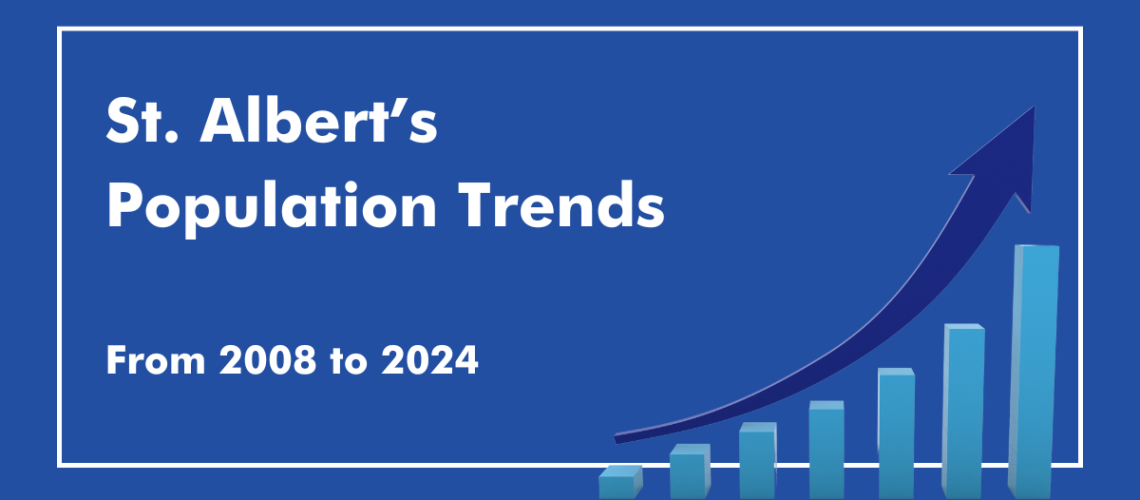The Evolution of St. Albert’s Population: From 2008 to 2024
St. Albert has experienced remarkable growth and demographic changes over the past 16 years, positioning itself as one of Alberta’s most desirable communities for families, retirees, and professionals alike. As a vibrant city just northwest of Edmonton, St. Albert’s real estate and property market reflect its steady rise in population, diverse age distribution, and growing demand for housing. In this blog, we explore how St. Albert’s population has evolved, identifying key trends, neighbourhood highlights, and what this means for the future of the community.
Steady Population Growth: A Snapshot of St. Albert’s Growth
Between 2008 and 2024, St. Albert’s population grew by over 23%, rising from 58,501 in 2008 to 72,316 in 2024. This growth averages an annual increase of about 1.4%, showcasing the city’s consistent appeal as a place to live, work, and raise a family.
| Year | Population | Growth | Average Annual Growth |
|---|---|---|---|
| 2008 | 58,501 | – | – |
| 2010 | 60,138 | 1,637 | 1.4% |
| 2012 | 60,994 | 856 | 0.7% |
| 2014 | 63,255 | 2,261 | 1.85% |
| 2016 | 64,645 | 1,390 | 1.1% |
| 2018 | 66,082 | 1,437 | 1.11% |
| 2024 | 72,316 | 6,234 | 1.51% |
While growth rates have varied across census periods, the post-2018 period saw a notable uptick, driven by new developments, economic recovery, and St. Albert’s continued reputation for high-quality living.
Neighbourhood Spotlight: Where is St. Albert Growing?
St. Albert’s neighbourhoods have played a pivotal role in accommodating the city’s expanding population. Some areas, particularly newer developments, have seen explosive growth, while others remain stable, catering to long-term residents.
Fastest-Growing Neighbourhoods (2018-2024)
- Jensen Lakes: Grew by 724.4%, from 225 residents in 2018 to 1,855 in 2024.
- Riverside: Increased by 418.7%, now home to 2,713 residents.
- Ville Giroux: Nearly doubled, growing by 99.7% to 637 residents.
| Neighbourhood | 2018 Population | 2024 Population | % Change |
|---|---|---|---|
| Jensen Lakes | 225 | 1,855 | 724.4% |
| Riverside | 523 | 2,713 | 418.7% |
| Ville Giroux | 319 | 637 | 99.7% |
| Erin Ridge North | 2,085 | 3,384 | 62.3% |
Established Neighbourhoods
Long-standing neighbourhoods like Grandin, Lacombe Park, and Deer Ridge continue to host a significant share of St. Albert’s population. Lacombe Park remains the largest neighbourhood, representing 10.9% of the city’s population in 2024.
Aging and Age Composition: Shifting Demographics
One of the most significant trends in St. Albert’s population is the aging demographic. The percentage of seniors (65+) has increased from 12% in 2008 to 22.1% in 2024, reflecting broader national trends.
| Age Group | 2008 % | 2018 % | 2024 % |
|---|---|---|---|
| 0-4 (Preschoolers) | 4.8% | 4.6% | 4.14% |
| 5-19 (School Age) | 21.9% | 20.0% | 19.5% |
| 20-34 (Young Adults) | 17.4% | 15.9% | 14.28% |
| 35-49 (Adults) | 23.5% | 20.2% | 20.46% |
| 50-64 (Mature Adults) | 21.4% | 21.5% | 19.47% |
| 65+ (Seniors) | 12.0% | 17.9% | 22.1% |
The aging population influences St. Albert property trends, increasing demand for downsized housing options, including condos, townhomes, and senior living facilities.
Housing Growth: Demand for St. Albert Real Estate
With population growth comes increased demand for housing. St. Albert’s real estate market has adapted by diversifying housing options.
- Single-Family Homes: Still dominant at 67.1% in 2024 but down from 75.7% in 2008.
- Higher-Density Housing: Apartments, townhouses, and duplexes have increased, making up 25.7% of the housing mix in 2024.
Table: Housing Mix in St. Albert (2008 vs. 2024)
| Housing Type | 2008 % | 2024 % |
|---|---|---|
| Single-Family Homes | 75.7% | 67.1% |
| Townhouses/Duplexes | 10.0% | 14.3% |
| Apartments | 9.9% | 19.1% |
The rise of higher-density housing reflects a growing preference for affordability and accessibility, particularly among young families and seniors downsizing from larger homes.
What Does the Future Hold for St. Albert?
As St. Albert continues to grow, the city will need to balance housing development, infrastructure investment, and services for a diverse population. The trends point to:
- Continued demand for St. Albert real estate, particularly in newer neighbourhoods.
- Increased focus on housing options for an aging population.
- Expansion of amenities and infrastructure to meet the needs of growing families in areas like Jensen Lakes and Riverside.
For those considering investing in St. Albert property or moving to this beautiful city, the consistent population growth, vibrant neighbourhoods, and quality of life make it a prime choice in Alberta’s real estate market.
Ready to explore St. Albert real estate opportunities? Contact us today to find your next home in this thriving community!




